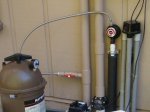My pump and filter are in a room of the poolhouse which is plumbed with a water supply. I planned to set things up so that I can add water directly to the pool plumbing instead of dragging out a hose.
My thinking is that I want to add the water on the suction side of the pump, which would mean I wouldn't have to worry about the pool pump pushing water into my water supply plumbing. I intend to use a check valve and ball valve in the supply line. I already have a threaded T in the inlet side of the pump that is currently plugged.
Anybody see any problems or have a better idea? I've looked into the remote type autofill devices, but I don't really see a need, and since I have such high alkalinity water, I prefer to be able to wait on forecast rain to fill the pool.
My thinking is that I want to add the water on the suction side of the pump, which would mean I wouldn't have to worry about the pool pump pushing water into my water supply plumbing. I intend to use a check valve and ball valve in the supply line. I already have a threaded T in the inlet side of the pump that is currently plugged.
Anybody see any problems or have a better idea? I've looked into the remote type autofill devices, but I don't really see a need, and since I have such high alkalinity water, I prefer to be able to wait on forecast rain to fill the pool.


